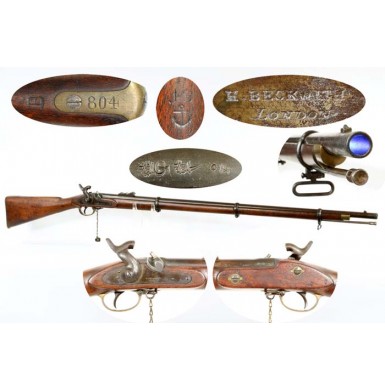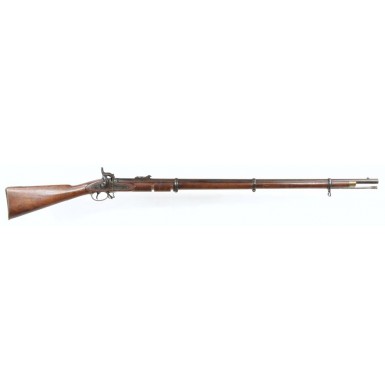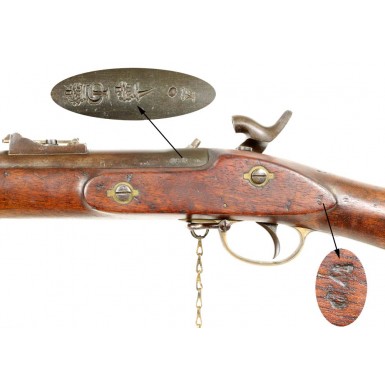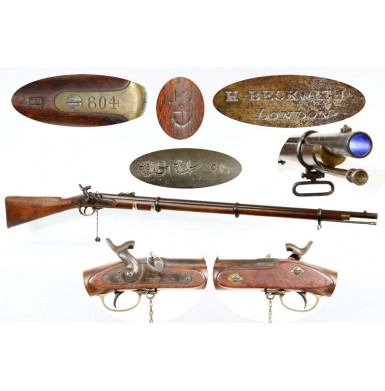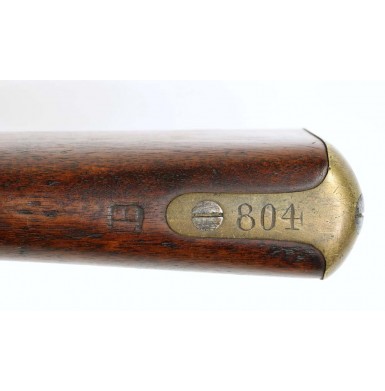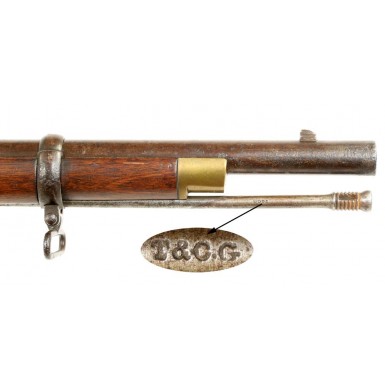Confederate Numbered P1853 Enfield by Beckwith
- Product Code: FLA-3428-SOLD
- Availability: Out Of Stock
-
$1.00
During the early days of the American Civil War, Confederate purchasing agents did a splendid job of tying up contracts for the British P1853 Enfield Rifle Musket, which was truly one of the most advanced and well-made military long arms of the day. According to Confederate Chief of Ordnance Josiah Gorgas's February 3, 1863 summary of imported arms, some 70,980 "Long Enfield Rifles" were purchased from the beginning of the war through the end of 1862. These numbers only account for Confederate central government purchases, and do not include those P-1853s purchased by the individual Confederate states or by speculators seeking to sell them within the Confederacy. The majority of these arms were purchased from the firms of S. Isaac, Campbell & Company (who relied on John Edward Barnett & Sons to deliver many of those arms) or Sinclair, Hamilton & Company, who often routed their sales through S. Isaac, Campbell & Co as well. Additional P-1853s were purchased from William Grazebrook of Liverpool, who made his first sales to Confederate purchasing agent Caleb Huse within 30 days of the opening of the war. Sinclair, Hamilton & Company entered into several contracts with the Confederacy to deliver P1853 Enfield Rifle Muskets, with the typical contract terms requiring 30,000 arms to be delivered over a six-month period. During the course of the war, Sinclair, Hamilton & Company appears to have received at least five of these contracts for P1853 Enfield Rifle Muskets from the Confederate central government. The second of these contracts for 30,000 P1853 "Long Enfields" is the one represented by the guns with the JS / (ANCHOR) mark, along with the engraved buttplate tang inventory numbers. These inventory numbers ran from 1-10,000 in three series (to date no gun with a 10,000 number is known, although theoretically they existed). The first series had no suffix after the number, while the second series of 10,000 had an "A" suffix under the inventory number and the third series of 10,000 had a "B" suffix. These numbered guns represent the October 1861 contract with Sinclair, Hamilton & Company that is referred to in Confederate documents as the "Second Contract". This contract required the 30,000 Enfields to be delivered between October of 1861 and April of 1862. At least two identified "B" suffix guns with 3-digit inventory numbers have been determined to have been issued in Corinth, MS immediately prior to the battle of Shiloh on April 6-7 of 1862. Thus, it is clear that the contract time line for production and delivery was closely followed, and the Confederacy did a good job delivering arms through the Union blockade during the first year of the war.
Sinclair, Hamilton & Company acquired their arms through "Five Furnishers". These were well-established gun making firms that were able to fill the large Sinclair, Hamilton & Company orders in a reasonable period of time. The "Five Furnishers" were the long time London gunmakers EP Bond, Parker, Field & Sons, and James Kerr. Kerr apparently received a tiny portion of the contract (only 500 guns) due to his position with the London Armoury Company. Archibald Hamilton of Sinclair, Hamilton & Company was the managing director of The London Armoury Company, and James Kerr (of Kerr revolver fame) was London Armoury Company's manager, having replaced his revolver designing rival Robert Adams in that position. The balance of the guns were delivered by the Birmingham based firms of C.W. James and W.C. Scott & Son. The furnishers often marked the guns that were delivered under this contract with a large single letter on the upper comb of the stock, just forward of the buttplate tang. The guns were marked with a B for Bond, an F for Parker, Field & Sons, a J for C.W. James, a K for James Kerr and an S for Scott & Son. A sixth single letter mark, P has been noted on extant Confederate Enfields from this contract. This mark was previously thought to be an alternate mark for Parker, Field & Company. However, more recent examination of extant examples and the other associated marks on those guns has revealed that this was the mark of Francis Preston of Manchester, England. Preston's relationship within the contracting circle of the "Five Furnishers" is not clear, but he delivered many socket bayonets for the numbered guns of this contract and may have received a small sub-contract to provide long arms as well. No period documents have shown that Preston delivered the guns directly to Sinclair, Hamilton & Company, so it is most likely that his guns were sub-contracted by James or Scott, who delivered the majority of the guns. As all of the "five furnishers" sub-contracted with other makers in order to deliver the requisite number of arms in a timely fashion, it is not uncommon to find a furnisher's initial on the stock comb that is not the same as the initial of the actual gunmakers name.
An October 31, 1861 dated letter from Sinclair, Hamilton & Co. notes that the contract was divided between the furnishers as follows: 8,000 guns from Scott & Son, 10,000 from CW James, 6,000 from E.P. Bond, 5,500 from Parker, Field & Sons and 500 from James Kerr. This indicates that the guns delivered by CW James (the largest supplier) represented about 33% of the total delivery under this contract, Scott & Sons about 25%, Bond about 20% and Parker, Field & Sons about 18% and the guns from Kerr represented less than 2% of the deliveries. An extensive database comprised of more than two decades of collected information related to Confederate purchased Enfields contains less than 300 numbered P1853 Enfield rifle muskets (not counting state purchased guns). Of those guns, the large majority (well more than half) are numbered guns with no suffix, representing about 74% of the recorded samples. A-suffix guns represent about 19% of the recorded examples, while B-suffix guns represent about 7% of surviving examples that are recorded. To date, less than 50 A-suffix and less than 20 B-suffix P1853 Enfields are known to exist. The reason for the paucity of these arms is not clear, but it may simply be the result of attrition and the arms having been used up. With B-suffix guns (which would have theoretically been delivered later than the no suffix or "A" guns), the lack of extant examples may be an indication of the early successes experienced by the Union's Atlantic Blockading Squadron. Recorded numbers show a good distribution of engraved numbers from two digits through the mid 2XXX range. Then there is then a nearly 4,000 number gap in the database that seems to indicate that a large number of the "B-guns" in the 25XX to 62XX range may well be on the bottom of the Atlantic Ocean. "A suffix" guns, although uncommon and with few examples to study, show a nice even distribution through the entire numbering sequence. This suggests that their scarcity today is the result of them having seen hard use, rather than having been dumped overboard while a Confederate blockade runner tried to elude a pursuing US Naval vessel.
The P1853 Enfield Rifle Musket offered here is a classic example of a Confederate marked and imported musket that clearly saw use in the field. The gun is in about NEAR FINE condition, especially for a Confederate purchased and used gun that was probably delivered no later than the first quarter of 1862. The gun retains a very legible J S / (ANCHOR) mark in the wood behind the trigger guard. The buttplate tang is engraved with the very low inventory number 804, indicating that this gun was one of the first 1,000 delivered under the 2nd Sinclair, Hamilton & Company contract. Based upon a study of extant examples, their inventory numbers and the lock dates on the Birmingham made guns, this rifle musket was likely produced during the fall of 1861 and was likely delivered prior to the end of that year. The gun bears a very crisp B furnishers mark, indicating that is was delivered to Sinclair, Hamilton & Company by E.P. Bond of London. The firm of Edward Philip Bond was one of the larger London gunmaking companies, which could trace their roots in the gun making business to the early 1700s, when the first Bond of the family was "Freed of the Gunmakers Company" (released from apprenticeship as a "master" gunmaker) in 1730. Over the next hundred years the family flourished in the gun trade, and in 1835 Edward Philip Bond was apprenticed to his uncle William Thomas Bond. In 1836, Edward was turned over to John Edward Barnett to continue his apprenticeship and was free of the Gunmakers Company in 1842. The time Bond spent apprenticed to Barnett no doubt established the long-time relationship between the two companies that continued well into the American Civil War era, as both firms became major suppliers of arms to the Confederacy. Although the gun was delivered by Bond against the 6,000 guns required of the firm by the contract, it was produced on sub-contracted by the London firm of Henry Beckwith. Beckwith was located at 58 Skinner Street in the Snow Hill neighborhood of London.
The lock of the gun is marked in two lines: H BECKWITH over LONDON forward of the lock, without the usual British "Crown" to the rear of the hammer. The gun bears no British military marks at all, which is typical of guns bound for commercial and export markets. The interior of the lock bears few marks other than the E.B. over the mainspring, along with three sets of assembly marks. It was standard practice for Birmingham gunmakers to use "Roman numeral" style file slash markings to mate the non-interchangeable parts of guns together. In London during this period, both the "Roman" numeral file slashes and Arabic numbers were used, sometime together at the same time. In this case, the lock internal parts are mating marked to the lock plate with small file marks \ | |, with the mark appearing on the upper edge of the plate and bridle. The upper edge of the lock plate carries a larger mating mark, \ \ which is found throughout the gun, on most of the major components. Finally, the Arabic number 6 is found inside the lock plate and the same number is found on the bottom of the barrel, mating those two components. The upper left of the breech is marked with the usual London commercial View, Proof and Definitive Proof marks. No gauge mark is present on the upper portion of the barrel, although a pair of 25 gauge marks (indicating .577 caliber) are present under the barrel. The bottom of the barrel is also marked by the guns' maker BECKWITH and by the barrel maker W MILLWARD. The rear of the breech plug is marked BOND. The mating mark 6 is also found on the bottom of the barrel. As noted the master assembly mark \ \ is found throughout the gun, appearing not only on the lock, but in the ramrod channel of the stock, on the necks of the breech plug and lock mounting screws, and on the inner rear edges of all three of the barrel bands.
As previously noted, the overall condition of the gun is about NEAR FINE, and for a Confederate used and carried rifle musket that probably arrived in the south sometime prior to the beginning of 1862, it is really in fine condition. The markings all remain clear and legible throughout and the lock retains some traces of original case coloring. The exposed metal of the gun has a mostly smooth plum brown patina mixed with traces and flecks of blue in protected areas. The bottom of the barrel retains about 30% of its original faded and dulled blued finish. Amazingly, the metal is mostly smooth; with some only some light-to-moderate surface oxidation, and some scattered peppering and minor pinpricking. As would be expected, the breech and bolster area do show light flash pitting, which is expected from a combat used percussion rifle musket. The bore of the musket is in about VERY GOOD condition. The bore of the gun is mottled bright and dark and retains strong 3-groove, progressive depth rifling. The bore shows light pitting along its entire length, with some scattered patches of more moderate pitting. The action of the gun is mechanically excellent and functions crisply on all positions. The brass furniture has a medium golden patina, which is very attractive. The original long-range rear sight is present and is complete and fully functional. The original front sight/bayonet lug is present near the muzzle as well. Both original sling swivels remain with the gun as well. The three original Palmer pattern clamping barrel bands all retain their tension screws and original doughnut-like keepers at their ends. An original, period, cone (nipple) protector is present on the gun as well. The original ramrod, which was numbered to the gun, is missing in action. This is typical with numbered Enfields, as less than 10% of extant examples retain a numbered ramrod (let alone the original matching one). The ramrod that now accompanies the gun is an original, P1853 ramrod from the period, which is full length and retains its original threads at the end. The rod is maker marked T&C.G, indicating that the Birmingham Small Work makers Thomas & Charles Gilbert produced the ramrod. The stock is in about VERY GOOD+ to NEAR FINE condition. The stock bears the expected JS / (ANCHOR) inspection mark in the wood behind the triggerguard. The mark is fairly crisp and quite legible. As noted earlier, a clear B furnishers mark is present on the top of the comb of the stock. The block letter mark W.D.is stamped at the tail of the flat, opposite the lock. This is probably the mark of the gun's "stocker" or possibly the "setter up". The stock is solid and complete and free of any breaks, repairs or significant damage. The stock does show the numerous bumps and dings from field service that would be expected. The stock shows some minor rounding of sharp edges and lines, but this most likely from carry, use and wear with and possibly an old cleaning. The legible and mostly crisp "JS/Anchor", "B" and "WD" marks suggest the stock has not been sanded.
Overall, this is really cool example of a completely authentic and original Confederate imported and used Enfield Rifle Musket that not only saw field service but was among the earliest of the numbered guns purchased and delivered. The gun has the most desirable and well known of all Confederate import marks, a wonderful JS / (ANCHOR). It also has a great engraved inventory number, and a crisp furnisher's mark. This gun was clearly a fairly early arrival in the Confederacy that was likely on the field before the beginning of 1862 and most assuredly fought in some of the major campaigns of the Civil War. The condition clearly shows that this gun saw service and fought for Southern independence during the course of the war but was always well cared for and never abused. Somehow, through all of that use and combat, the gun managed to survive in very nice, complete condition. This gun fought the war for the Confederate cause and is one of those weapons that you wish could tell you its story. With only 1 in 5 JS / (ANCHOR) marked long Enfields having been delivered by E.P Bond, and with less than 1% of those 30,000 guns having survived to be in collections today, this is simply an incredibly scarce example of a Confederate purchased gun. If you have ever wanted to own a completely correct and honest Confederate used P1853 Enfield Rifle Musket, that really saw service and fought the war, this would be a great addition to your collection. This gun is an iconic piece of history, which was no doubt a witness to some of the most horrific moments in the American Civil War.
SOLD
